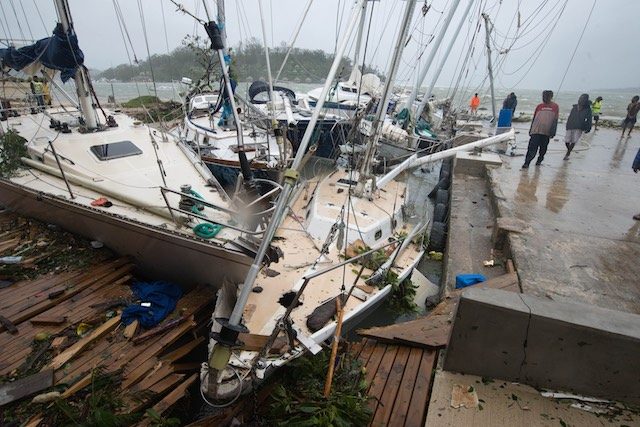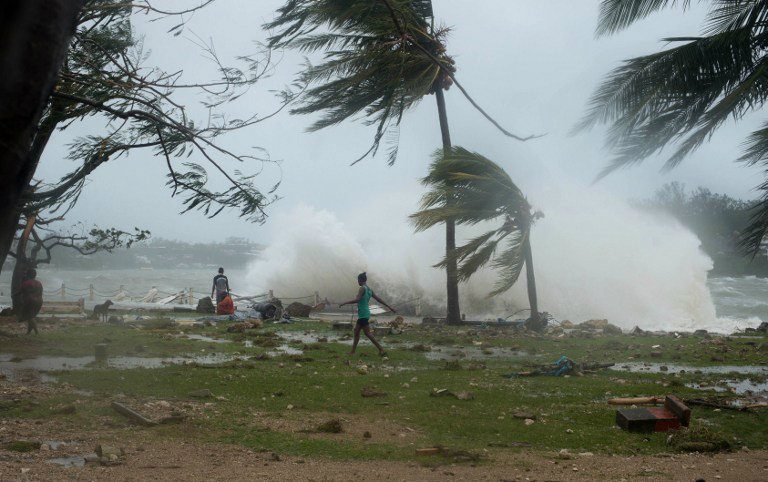SUMMARY
This is AI generated summarization, which may have errors. For context, always refer to the full article.

SUVA, Fiji (2nd UPDATE) – Cyclone-devastated Vanuatu declared a state of emergency Sunday, March 15, as relief agencies desperately scrambled to get help to the impoverished Pacific nation amid reports entire villages were “blown away” when a monster storm swept through.
The official death toll stood at 6 on Sunday, although the UN had unconfirmed reports of 44 people killed in just one province after Super Cyclone Pam, a maximum Category 5 storm, tore through.
Oxfam said up to 90% of houses in Port Vila were damaged as winds of up to 320 kilometers (200 miles) an hour lashed the country when the storm hit Friday night, March 13.
It said the scale of the disaster would not be known until reports filter in from outlying islands.
“This is likely to be one of the worst disasters ever seen in the Pacific, the scale of humanitarian need will be enormous… entire communities have been blown away,” Oxfam’s Vanuatu director Colin Collet van Rooyen said.
Aid workers described destroyed homes, uprooted trees and blocked roads following what UNICEF spokeswoman Alice Clements said was “15-30 minutes of absolute terror” as the cyclone barreled into the island.
“People have no water, they have no power, this is a really desperate situation right now, people need help,” she told Agence France-Presse.
Clements said most of the dwellings on Port Vila’s impoverished outskirts, which largely consist of tin shacks, stood no chance in the ferocious bettering.
“People tried to tie down their roofs, they put bricks on them but it’s total destruction, they’ve been absolutely flattened,” she said.
“I was talking to to people who were sheltering in a church. It was destroyed and they had to run for their lives.
“People are collecting the fruit that’s been blown on the ground, then they’ll go onto their root crops and after that they’ve got no food.”
Communications remained down across most of the country, making it difficult to assess the scale of the damage, particularly on outlying islands that were directly in the storm’s path.
Oxfam’s executive director Helen Szoke said it was a “worse than worst case scenario”.
“These islands have much less infrastructure than the capital of Port Vila and are extremely remote and hard to reach in the best of times,” she said.
“We hold grave fears for (these) people.”
World Vision spokeswoman Chloe Morrison said timber dwellings on the palm-fringed islands were “delicate structures”, adding: “We’re seeing whole villages and houses blown away.”
Vanuatu National Disaster Management Office spokesman Paulo Malatu said the 6 confirmed deaths were all in Port Vila.

“We’re expecting that to go up as we get more information in from elsewhere,” he said, confirming a state of emergency had been declared for the entire country.
Appeal for aid
Vanuatu’s President Baldwin Lonsdale led appeals for international assistance, telling delegates at a UN conference on disaster risk reduction in Japan Saturday, March 14, that he spoke with a “heart that is so heavy”.
“I stand to appeal on behalf of the government and people of Vanuatu to the global community to give a lending hand in responding to these very current calamities that have struck us,” Lonsdale said.
NGOs have also launched appeals and are hoping to start flying in emergency supplies of food, shelter and medicine from Sunday, when the airport in the capital Port Vila is expected to reopen.
Australia said it was sending Aus$5 million in aid and deploying disaster teams, with Foreign Minister Julie Bishop saying help was also being sent to neighboring Tuvalu.
“Tuvalu has announced a state of emergency and we are responding to that request with basic supplies, water, sanitation, tents, blankets and food,” she said.
There were no casualty figures from Tuvalu.
Other donations for Vanuatu included $2.9 million from Britain, $733,750 by New Zealand and $1.05 million from the European Union. President Francois Hollande also said France would respond to requests for assistance.
“A disaster of this magnitude has not been experienced by Vanuatu in recent history – particularly in terms of the reach of the potential damage and the ferocity of the storm,” said Sune Gudnitz, who heads the United Nations Office for the Coordination of Humanitarian Affairs in the Pacific.
UNICEF New Zealand Executive Director Vivien Maidaborn said “early reports are indicating that this weather disaster could potentially be one of the worst in Pacific history”.
“The sheer force of the storm combined with communities just not set up to withstand it, could have devastating results for thousands across the region.” – Joshua Kuku, AFP / Rappler.com
Add a comment
How does this make you feel?
There are no comments yet. Add your comment to start the conversation.